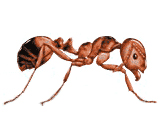Characteristics
Size: There are many sizes of workers in the colony, ranging from 1/8-inch to almost 3/8-inch in length.
Color: Reddish brown.
It is easily distinguished from other ants if one is unlucky enough to be stung.
Behavior
Fire ants pose a health risk to anyone venturing into areas where the ants are found. Although the vast majority of stings result only in a raised welt that may develop a white pustule, a person allergic to insect stings could experience a more serious reaction. Additionally, a person seldom receives just one sting. Rather, dozens or even hundreds of stings can be inflicted quickly on a person accidentally kneeling or standing next to or on a fire ant mound.
Habitat
These ants nest in the soil and construct large mounds that are easily seen in lawns and pastures. A single lawn may contain a dozen or more mounds. This ant will also locate nests within landscape mulch and beneath items on the ground, such as landscape timbers. The mounds of such colonies may be shallow and poorly structured, making them difficult to detect for the less experienced eye. Fire ants may construct mounds next to the foundation and enter homes through weep holes or other exterior cracks and holes. Once inside, workers forage in trails beneath the edge of carpeting. On occasion, the ants will bring soil up into walls or beneath first floor bathrooms and construct a nest.



